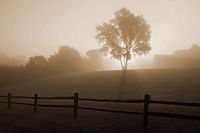Visibility facts for kids
Visibility is a word used in meteorology. It is used to talk about how far a normal person can see depending on the weather. If there is low visibility, such as in a blizzard, a person will not be able to see far. If there is high visibility, such as on a bright, sunny day, a person will be able to see a long way.
Visibility less than 100 metres (330 ft) is often called zero. When it is this low, roads may be closed, or lights and signs are turned on to warn drivers. These are put in areas that often have very low visibility. Warning lights help stop accidents. Automobile crashes with many cars happen often in places like this if the warning lights and signs are not put up.
Visibility is said to be good when a person can see farther than about 10 kilometers.
An advisory is put out by meteorologists to warn of low visibility, such as a dense fog advisory from the U.S. National Weather Service. These tell drivers to not travel until the fog leaves. Airport travel sometimes is delayed, or slowed down, by low visibility.
Images for kids
-
Foggy morning road
See also
 In Spanish: Visibilidad para niños
In Spanish: Visibilidad para niños




